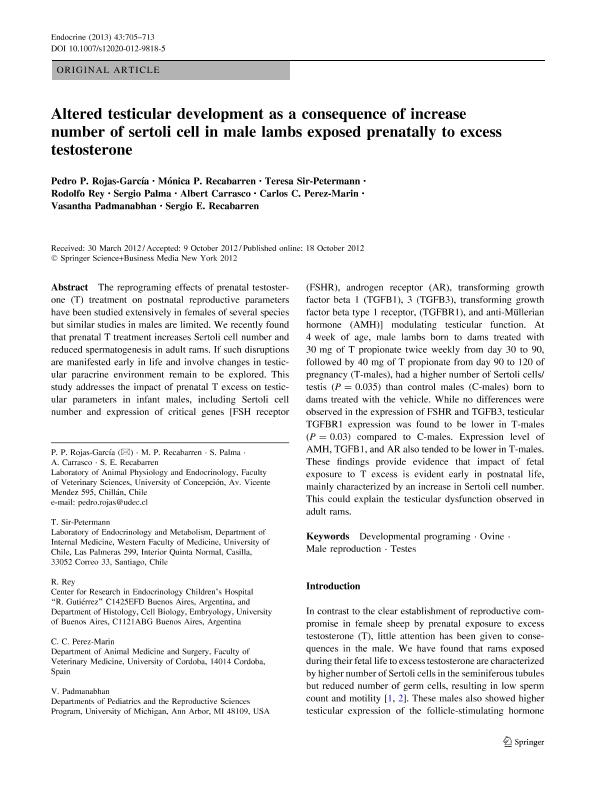Artículo
Altered testicular development as a consequence of increase number of sertoli cell in male lambs exposed prenatally to excess testosterone
Rojas García, Pedro P.; Recabarren, Mónica P.; Sir Petermann, Teresa; Rey, Rodolfo Alberto ; Palma, Sergio; Carrasco, Albert; Pérez Marín, Carlos C.; Padmanabhan, Vasantha; Recabarren, Sergio E.
; Palma, Sergio; Carrasco, Albert; Pérez Marín, Carlos C.; Padmanabhan, Vasantha; Recabarren, Sergio E.
 ; Palma, Sergio; Carrasco, Albert; Pérez Marín, Carlos C.; Padmanabhan, Vasantha; Recabarren, Sergio E.
; Palma, Sergio; Carrasco, Albert; Pérez Marín, Carlos C.; Padmanabhan, Vasantha; Recabarren, Sergio E.
Fecha de publicación:
06/2013
Editorial:
Humana Press
Revista:
Endocrine
ISSN:
0969-711X
Idioma:
Inglés
Tipo de recurso:
Artículo publicado
Clasificación temática:
Resumen
The reprograming effects of prenatal testosterone (T) treatment on postnatal reproductive parameters have been studied extensively in females of several species but similar studies in males are limited. We recently found that prenatal T treatment increases Sertoli cell number and reduced spermatogenesis in adult rams. If such disruptions are manifested early in life and involve changes in testicular paracrine environment remain to be explored. This study addresses the impact of prenatal T excess on testicular parameters in infant males, including Sertoli cell number and expression of critical genes [FSH receptor (FSHR), androgen receptor (AR), transforming growth factor beta 1 (TGFB1), 3 (TGFB3), transforming growth factor beta type 1 receptor, (TGFBR1), and anti-Mullerian hormone (AMH)] modulating testicular function. At 4 week of age, male lambs born to dams treated with 30 mg of T propionate twice weekly from day 30 to 90, followed by 40 mg of T propionate from day 90 to 120 of pregnancy (T-males), had a higher number of Sertoli cells/ testis compared to C-males. Expression level of AMH, TGFB1, and AR also tended to be lower in T-males. These findings provide evidence that impact of fetal exposure to T excess is evident early in postnatal life, mainly characterized by an increase in Sertoli cell number. This could explain the testicular dysfunction observed in adult rams.
Palabras clave:
Developmental Programing
,
Ovine
,
Male Reproduction
,
Testes
Archivos asociados
Licencia
Identificadores
Colecciones
Articulos(CEDIE)
Articulos de CENTRO DE INVESTIGACIONES ENDOCRINOLOGICAS "DR. CESAR BERGADA"
Articulos de CENTRO DE INVESTIGACIONES ENDOCRINOLOGICAS "DR. CESAR BERGADA"
Citación
Rojas García, Pedro P.; Recabarren, Mónica P.; Sir Petermann, Teresa; Rey, Rodolfo Alberto; Palma, Sergio; et al.; Altered testicular development as a consequence of increase number of sertoli cell in male lambs exposed prenatally to excess testosterone; Humana Press; Endocrine; 43; 3; 6-2013; 705-713
Compartir
Altmétricas



